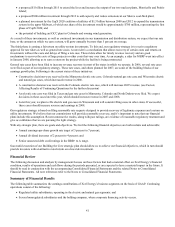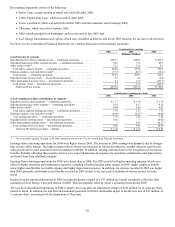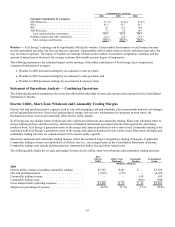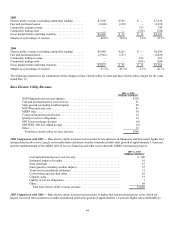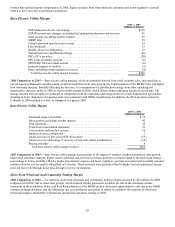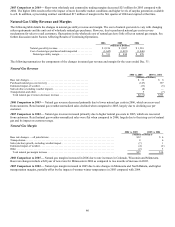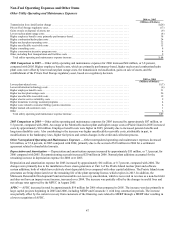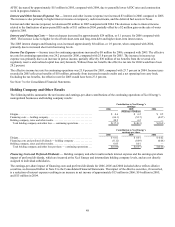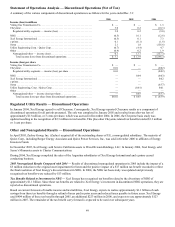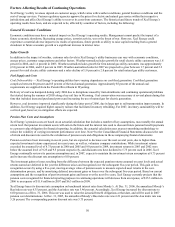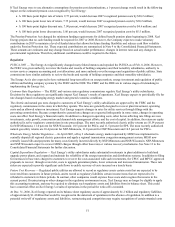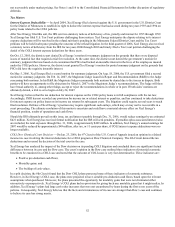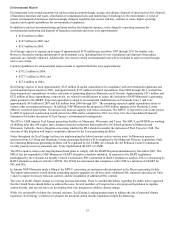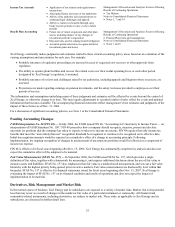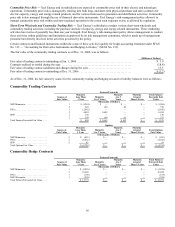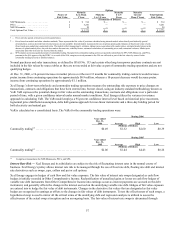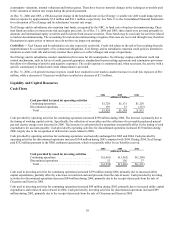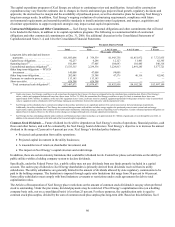Xcel Energy 2006 Annual Report Download - page 60
Download and view the complete annual report
Please find page 60 of the 2006 Xcel Energy annual report below. You can navigate through the pages in the report by either clicking on the pages listed below, or by using the keyword search tool below to find specific information within the annual report.50
Factors Affecting Results of Continuing Operations
Xcel Energy’s utility revenues depend on customer usage, which varies with weather conditions, general business conditions and the
cost of energy services. Various regulatory agencies approve the prices for electric and natural gas service within their respective
jurisdictions and affect Xcel Energy’s ability to recover its costs from customers. The historical and future trends of Xcel Energy’s
operating results have been, and are expected to be, affected by a number of factors, including the following:
General Economic Conditions
Economic conditions may have a material impact on Xcel Energy’s operating results. Management cannot predict the impact of a
future economic slowdown, fluctuating energy prices, terrorist activity, war or the threat of war. However, Xcel Energy could
experience a material adverse impact to its results of operations, future growth or ability to raise capital resulting from a general
slowdown in future economic growth or a significant increase in interest rates.
Sales Growth
In addition to the impact of weather, customer sales levels in Xcel Energy’s utility businesses can vary with economic conditions,
energy prices, customer usage patterns and other factors. Weather-normalized sales growth for retail electric utility customers was 1.8
percent in 2006, and 1.4 percent in 2005. Weather-normalized sales growth for firm natural gas utility customers was approximately
(2.8) percent in 2006, and 0.2 percent in 2005. Weather-normalized sales for 2007 are projected to grow between 1.7 percent and 2.2
percent for retail electric utility customers and a sales decline of 1.0 percent to 2.0 percent for retail natural gas utility customers.
Fuel Supply and Costs
Coal Deliverability — Xcel Energy’s operating utilities have varying dependence on coal-fired generation. Coal-fired generation
comprises between 60 percent and 85 percent of the total annual generation. Approximately 85 percent of the annual coal
requirements are supplied from the Powder River Basin in Wyoming.
Delivery of coal was hampered during early 2006 due to disruptions caused by train derailments and continuing operational problems
that started during the summer of 2005 along a key rail line in Wyoming. Coal conservation was necessary at several plants during this
time that included increased purchased power and increasing the use of natural gas for electric generation.
However, coal inventory improved significantly during the latter part of 2006, due in large part to rail transportation improvements. In
addition, Xcel Energy acquired higher capacity railcars that facilitated inventory rebuilding. For 2007, inventory sustainability will be
a critical goal, however, no mitigation efforts are expected.
Pension Plan Costs and Assumptions
Xcel Energy’s pension costs are based on an actuarial calculation that includes a number of key assumptions, most notably the annual
return level that pension investment assets will earn in the future and the interest rate used to discount future pension benefit payments
to a present value obligation for financial reporting. In addition, the actuarial calculation uses an asset-smoothing methodology to
reduce the volatility of varying investment performance over time. Note 9 to the Consolidated Financial Statements discusses the rate
of return and discount rate used in the calculation of pension costs and obligations in the accompanying financial statements.
Pension costs have been increasing in recent years, but are expected to decrease over the next several years, due to higher-than-
expected investment returns experienced in recent years, as well as, voluntary company contributions. While investment returns
exceeded the assumed level of 8.75 percent in 2006 and 2005 and 9.0 percent in 2004, investment returns in 2003 and 2002 were
below the assumed level of 9.25 and 9.5 percent respectively, and discount rates have declined to 5.75 percent used in 2006. Xcel
Energy continually reviews its pension assumptions and, in 2007, expects to maintain the investment return assumption at 8.75 percent
and to increase the discount rate assumption to 6.00 percent.
The investment gains or losses resulting from the difference between the expected pension returns assumed on asset levels and actual
returns earned are deferred in the year the difference arises and recognized over the subsequent five-year period. This gain or loss
recognition occurs by using a five-year, moving-average value of pension assets to measure expected asset returns in the cost-
determination process, and by amortizing deferred investment gains or losses over the subsequent five-year period. Based on current
assumptions and the recognition of past investment gains and losses over the next five years, Xcel Energy currently projects that the
pension costs recognized for financial reporting purposes in continuing operations will decrease from an expense, of $15.3 million in
2006 to an expense of $11.8 million in 2007 and $6.3 million in 2008.
Xcel Energy bases its discount rate assumption on benchmark interest rates from Moody’s. At Dec. 31, 2006, the annualized Moody’s
Baa index rate was 6.35 percent, and the Aaa index rate was 5.46 percent. Accordingly, Xcel Energy increased the discount rate to
6.00 percent as of Dec. 31, 2006. This rate was used to value the actuarial benefit obligations at that date, and will be used in 2007
pension cost determinations. At Dec. 31, 2005, the annualized Moody’s Baa index rate was 6.21 percent and the Aaa index rate was
5.26 percent. The corresponding pension discount rate was 5.75 percent.



